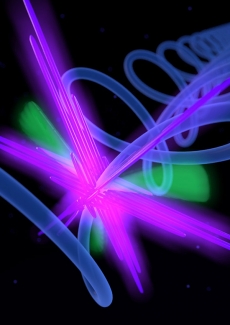Until recently, researchers who wanted to understand how magnetic materials work had to reserve time on a large, stadium-sized X-ray machine called a synchrotron. Synchrotrons can produce X-ray beams that can be sculpted very precisely to capture how the spins in magnetic materials work together to give us beautiful and useful magnetic properties – for example to store data in a computer hard drive. But now, thanks to Patrik Grychtol and his colleagues in the Kapteyn/Murnane group, there’s a way to conduct this kind of research in a small university laboratory.
The JILA team, with their collaborators from Oren Cohen’s group at Technion in Israel, developed a method for creating coherent (laser-like) polarized extreme ultraviolet (EUV) and soft x-rays that are bright enough to investigate how magnetic materials work on the fastest time and smallest length scales. This new method is an extension of high-harmonic generation (HHG). In ordinary HHG, a strong laser field rips an electron from an atom such as argon or some other noble gas. The electrons then smash back into their parent ions twice during the laser optical cycle, producing coherent x-rays in the process.
The new approach uses two laser beams with different colors, each circularly polarized but in opposite directions. With these two beams, the electrons are ripped away from the atoms and recombine three times in a cloverleaf pattern! More importantly, billions of atoms do this all at the same time, creating a bright beam of circularly polarized EUV light that can be used for studying the magnetic properties of many important materials.
On the polarized express (as with other HHG research), it’s like the laser field is the conductor of an orchestra and billions of noble gas atoms are the musicians. In the lab, the goal is to get as many atomic musicians (atoms) as there are people on Earth all singing in tune and under the conductor’s (laser) baton. If the atoms all “play” at the same time, you get the loudest music (brightest beam of EUV light). Grychtol and his colleagues figured out how to perform this amazing feat! This important work was reported online in Nature Photonics on December 8, 2014.
The experimentalists responsible for this breakthrough include research associate Patrik Grychtol, recent JILA Ph.D. Emrah Turgut, graduate students Dmitriy Zusin and Dimitar Popmintchev, senior research associate Tenio Pommintchev, Fellows Margaret Murnane and Henry Kapteyn as well as NIST colleagues Ronny Knut, Hans Nembach, and Justin Shaw. The theorists were Ofer Kfir, Avner Fleischer, and Oren Cohen of Technion [Israel Institute of Technology (Haifa)]. Cohen also conducted preliminary experiments on generating circularly polarized EUV light at Technion and was a recent JILA Visiting Fellow.
Once they had made the first bright beam of circularly polarized EUV HHG beams, the researchers had to prove how bright it was since it was undetectable by human eyes or lab electronics. So, they showed they could use it to study the magnetic properties of cobalt. The transmission of magnetic materials such as Cobalt depends on whether the magnetic spins of the atoms inside the material are oriented up or down. Because they had a new source of circularly polarized EUV HHG beams, the researchers were able to measure the magnetic properties of cobalt using their tabletop setup. In the process, they replicated a similar study of performed at a synchrotron, showing that the tabletop method in the lab is complementary to a synchrotron—but less expensive and easier to access.
This important work is expected to lead to a new understanding of complex magnetic materials by detecting how different atoms and spins behave inside them.—Julie Phillips and Margaret Murnane




